Testing of Chemically Activated Cellulose Fibers as Adsorbents for Treatment of Arsenic Contaminated Water
Abstract
:1. Introduction
2. Materials and Methods
2.1. Adsorbent Preparation
2.1.1. Fiber Preparation
2.1.2. Fibers Oxidation
2.1.3. Functionalization of Synthesized Viscose
2.2. Adsorbent Characterization
2.2.1. Characterization of TEMPO-Mediated Viscose Fibers
Fourier Transform Infrared Spectroscopy/Attenuated Total Internal Reflection Spectroscopy (FT-IR/ATR)
X-ray Diffractometry
Thermogravimetric Analyses
2.2.2. Characterization of the Adsorbent
2.3. Bach Adsorption Experiments
3. Results and Discussions
3.1. Characterization of Synthesized Viscose
3.2. Characterized of V-DEHPA-Fe and VF-DEHPA-Fe Materials
3.2.1. X-ray Energy Dispersive Spectroscopy
3.2.2. FTIR Infrared Spectroscopy Analysis with Fourier Transformed
3.2.3. Effect of pH
3.2.4. Effect of Contact Time and Temperature and Adsorption Kinetics/Thermodynamics
3.3. The Effect of Initial As(V) Concentration and Adsorption Isotherms
4. Conclusions
Author Contributions
Funding
Institutional Review Board Statement
Informed Consent Statement
Data Availability Statement
Conflicts of Interest
References
- Mandal, B.K.; Suzuki, K.T. Arsenic round the world: A review. Talanta 2002, 58, 201–235. [Google Scholar] [CrossRef]
- Sharma, V.K.; Sohn, M. Aquatic arsenic: Toxicity, speciation, transformations, and remediation. Environ. Int. 2009, 35, 743–759. [Google Scholar] [CrossRef]
- Zhao, F.-J.; McGrath, S.P.; Meharg, A.A. Arsenic as a Food Chain Contaminant: Mechanisms of Plant Uptake and Metabolism and Mitigation Strategies. Annu. Rev. Plant Biol. 2010, 61, 535–559. [Google Scholar] [CrossRef] [PubMed] [Green Version]
- Gupta, D.K.; Srivastava, S.; Huang, H.G.; Romero-Puertas, M.C.; Sandalio, L.M. Arsenic Tolerance and Detoxification Mechanisms in Plants. In Detoxification of Heavy Metals; Sherameti, I., Varma, A., Eds.; Springer: Berlin, Germany, 2011. [Google Scholar]
- Singh, R.; Singh, S.; Parihar, P.; Singh, V.P.; Prasad, S.M. Arsenic contamination, consequences and remediation techniques: A review. Ecotoxicol. Environ. Saf. 2015, 112, 247–270. [Google Scholar] [CrossRef] [PubMed]
- Sohel, N.; Persson, L.Å.; Rahman, M.; Streatfiled, P.K.; Yunus, M.; Ekström, E.-C.; Vahter, M. Arsenic in Drinking Water and Adult Mortality: A Population-based Cohort Study in Rural Bangladesh. Epidemiology 2009, 20, 824–830. [Google Scholar] [CrossRef]
- Li, G.; Sun, G.-X.; Williams, P.N.; Nunes, L.; Zhu, Y.-G. Inorganic arsenic in Chinese food and its cancer risk. Environ. Int. 2011, 37, 1219–1225. [Google Scholar] [CrossRef] [Green Version]
- Argos, M.; Kalra, T.; Rathouz, P.J.; Chen, Y.; Pierce, B.; Parvez, F.; Islam, T.; Ahmed, A.; Rakibuz-Zaman, M.; Hasan, R.; et al. Arsenic exposure from drinking water, and all-cause and chronic-disease mortalities in Bangladesh (HEALS): A prospective cohort study. Lancet 2010, 376, 252–258. [Google Scholar] [CrossRef] [Green Version]
- Taleb, K.; Markovski, J.; Veličković, Z.; Rusmirović, J.; Rančić, M.; Pavlović, V.; Marinković, A. Arsenic removal by magnetite-loaded amino modified nano/microcellulose adsorbents: Effect of functionalization and media size. Arab. J. Chem. 2016, 12, 4675–4693. [Google Scholar] [CrossRef] [Green Version]
- Ravenscroft, P.; Brammer, H.; Richards, K. Arsenic Pollution: A Global Synthesis; John Wiley & Sons Ltd.: Oxford, UK, 2009. [Google Scholar]
- Awual, M.R.; Shenashen, M.A.; Yaita, T.; Shiwaku, H.; Jyo, A. Efficient arsenic(V) removal from water by ligand exchange fibrous adsorbent. Water Res. 2012, 46, 5541–5550. [Google Scholar] [CrossRef]
- National Research Council. Arsenic in Drinking Water. 1999. Available online: https://www.ncbi.nlm.nih.gov/books/NBK230893/ (accessed on 12 June 2021).
- Horward, G. Arsenic. 2018. Available online: https://www.who.int/news-room/fact-sheets/detail/arsenic (accessed on 11 June 2021).
- Song, S.; Lopez-Valdivieso, A.; Hernandez-Campos, D.; Peng, C.; Monroy-Fernandez, M.; Razo-Soto, I. Arsenic removal from high-arsenic water by enhanced coagulation with ferric ions and coarse calcite. Water Res. 2006, 40, 364–372. [Google Scholar] [CrossRef]
- Parga, J.R.; Cocke, D.L.; Valenzuela, J.L.; Gomes, J.A.; Kesmez, M.; Irwin, G.; Moreno, H.; Weir, M. Arsenic removal via electrocoagulation from heavy metal contaminated groundwater in La Comarca Lagunera México. J. Hazard. Mater. 2005, 124, 247–254. [Google Scholar] [CrossRef]
- Balasubramanian, N.; Kojima, T.; Basha, C.A.; Srinivasakannan, C. Removal of arsenic from aqueous solution using electrocoagulation. J. Hazard. Mater. 2009, 167, 966–969. [Google Scholar] [CrossRef] [PubMed]
- Mohan, D.; Pittman, C.U., Jr. Arsenic removal from water/wastewater using adsorbents—A critical review. J. Hazard. Mater. 2007, 142, 1–53. [Google Scholar] [CrossRef] [PubMed]
- Muntean, C.; Negrea, A.; Ciopec, M.; Lupa, L.; Negrea, P.; Rosu, D. Studies Regarding the Arsenic Removal from Water. Chem. Bull. Politeh. Univ. Timis. 2009, 54, 18–20. [Google Scholar]
- Bora, A.J.; Gogoi, S.; Baruah, G.; Dutta, R.K. Utilization of co-existing iron in arsenic removal from groundwater by oxidation-coagulation at optimized pH. J. Environ. Chem. Eng. 2016, 4, 2683–2691. [Google Scholar] [CrossRef]
- Ji, J.; Yun, Y.; Zeng, Z.; Wang, R.; Zheng, X.; Deng, L.; Li, C. Preparation and arsenic adsorption assessment of PPESK ultrafiltration membranes with organic/inorganic additives. Appl. Surf. Sci. 2015, 351, 715–724. [Google Scholar] [CrossRef]
- Zhao, D.; Yu, Y.; Wang, C.; Chen, J.P. Zirconium/PVA modified flat-sheet PVDF membrane as a cost-effective adsorptive and filtration material: A case study on decontamination of organic arsenic in aqueous solutions. J. Colloid Interface Sci. 2016, 477, 191–200. [Google Scholar] [CrossRef]
- Salazar, H.; Nunes-Pereira, J.; Correia, D.; Cardoso, V.; Gonçalves, R.; Martins, P.; Ferdov, S.; Martins, M.; Botelho, G.; Lanceros-Mendez, S. Poly(vinylidene fluoride-hexafluoropropylene)/bayerite composite membranes for efficient arsenic removal from water. Mater. Chem. Phys. 2016, 183, 430–438. [Google Scholar] [CrossRef]
- Dhoble, R.M.; Maddigapu, P.R.; Rayalu, S.S.; Bhole, A.; Dhoble, A.S.; Dhoble, S.R. Removal of arsenic(III) from water by magnetic binary oxide particles (MBOP): Experimental studies on fixed bed column. J. Hazard. Mater. 2017, 322, 469–478. [Google Scholar] [CrossRef]
- Vithanage, M.; Herath, I.; Joseph, S.; Bundschuh, J.; Bolan, N.; Ok, Y.S.; Kirkham, M.; Rinklebe, J. Interaction of arsenic with biochar in soil and water: A critical review. Carbon 2017, 113, 219–230. [Google Scholar] [CrossRef]
- Suda, A.; Makino, T. Functional effects of manganese and iron oxides on the dynamics of trace elements in soils with a special focus on arsenic and cadmium: A review. Geoderma 2016, 270, 68–75. [Google Scholar] [CrossRef]
- Lata, S.; Samadder, S.R. Removal of arsenic from water using nano adsorbents and challenges: A review. J. Environ. Manag. 2016, 166, 387–406. [Google Scholar] [CrossRef]
- Rahim, M.; Mas Haris, M.R.H. Application of biopolymer composites in arsenic removal from aqueous medium: A review. J. Radiat. Res. Appl. Sci. 2015, 8, 255–263. [Google Scholar] [CrossRef] [Green Version]
- Roy, P.; Mondal, N.K.; DAS, K. Modeling of the adsorptive removal of arsenic: A statistical approach. J. Environ. Chem. Eng. 2014, 2, 585–597. [Google Scholar] [CrossRef]
- Borah, D.; Satokawa, S.; Kato, S.; Kojima, T. Sorption of As(V) from aqueous solution using acid modified carbon black. J. Hazard. Mater. 2009, 162, 1269–1277. [Google Scholar] [CrossRef]
- Hutia, P.; Kato, S.; Kojima, T.; Satokawa, S. Adsorption of As(V) on surfactant-modified natural zeolites. J. Hazard. Mater. 2009, 162, 204–211. [Google Scholar]
- Borah, D.; Satokawa, S.; Kato, S.; Kojima, T. Surface-modified carbon black for As(V) removal. J. Colloid Interface Sci. 2008, 319, 53–62. [Google Scholar] [CrossRef] [PubMed]
- Maji, S.K.; Pal, A.; Pal, T. Arsenic removal from real-life groundwater by adsorption on laterite soil. J. Hazard. Mater. 2008, 151, 811–820. [Google Scholar] [CrossRef] [PubMed]
- Gupta, K.; Ghosh, U.C. Arsenic removal using hydrous nanostructure iron(III)–titanium(IV) binary mixed oxide from aqueous solution. J. Hazard. Mater. 2009, 161, 884–892. [Google Scholar] [CrossRef]
- Banerjee, K.; Amy, G.L.; Prevost, M.; Nour, S.; Jekel, M.; Gallagher, P.M.; Blumenschein, C.D. Kinetic and thermodynamic aspects of adsorption of arsenic onto granular ferric hydroxide (GFH). Water Res. 2008, 42, 3371–3378. [Google Scholar] [CrossRef] [PubMed]
- Partey, F.; Norman, D.; Ndur, S.; Nartey, R. Arsenic sorption onto laterite iron concretions: Temperature effect. J. Colloid Interface Sci. 2008, 321, 493–500. [Google Scholar] [CrossRef]
- Ohe, K.; Tagai, Y.; Nakamura, S.; Oshima, T.; Baba, Y. Adsorption Behavior of Arsenic(III) and Arsenic(V) Using Magnetite. J. Chem. Eng. Jpn. 2005, 38, 671–676. [Google Scholar] [CrossRef]
- Jeong, Y.; Fan, M.; Singh, S.; Chuang, C.-L.; Saha, B.; van Leeuwen, J.H. Evaluation of iron oxide and aluminum oxide as potential arsenic(V) adsorbents. Chem. Eng. Process. Process Intensif. 2007, 46, 1030–1039. [Google Scholar] [CrossRef]
- Hsu, J.-C.; Lin, C.-J.; Liao, C.-H.; Chen, S.-T. Removal of As(V) and As(III) by reclaimed iron-oxide coated sands. J. Hazard. Mater. 2008, 153, 817–826. [Google Scholar] [CrossRef] [PubMed]
- Nguyen, V.T.; Vigneswaran, S.; Ngo, H.H.; Shon, H.K.; Kandasamy, J. Arsenic removal by a membrane hybrid filtration system. Desalination 2009, 236, 363–369. [Google Scholar] [CrossRef] [Green Version]
- Chen, Y.-N.; Chai, L.-Y.; Shu, Y.-D. Study of arsenic(V) adsorption on bone char from aqueous solution. J. Hazard. Mater. 2008, 160, 168–172. [Google Scholar] [CrossRef]
- Bissen, M.; Frimmel, F.H. Arsenic—A Review. Part II: Oxidation of Arsenic and its Removal in Water Treatment. Acta Hydrochim. Hydrobiol. 2003, 31, 97–107. [Google Scholar] [CrossRef]
- Wang, L.; Chen, A.S.; Sorg, T.J.; Fields, K.A. Field Evaluation of as Removal by IX and AA. J. Am. Water Works Assoc. 2002, 94, 161–173. [Google Scholar] [CrossRef]
- Qu, D.; Wang, J.; Hou, D.; Luan, Z.; Fan, B.; Zhao, C. Experimental study of arsenic removal by direct contact membrane distillation. J. Hazard. Mater. 2009, 163, 874–879. [Google Scholar] [CrossRef]
- Ning, R.Y. Arsenic removal by reverse osmosis. Desalination 2002, 143, 237–241. [Google Scholar] [CrossRef]
- Košutić, K.; Furač, L.; Sipos, L.; Kunst, B. Removal of arsenic and pesticides from drinking water by nanofiltration membranes. Sep. Purif. Technol. 2005, 42, 137–144. [Google Scholar] [CrossRef]
- Kim, J.; Benjamin, M.M. Modeling a novel ion exchange process for arsenic and nitrate removal. Water Res. 2004, 38, 2053–2062. [Google Scholar] [CrossRef] [PubMed]
- Masotti, A. Closed Cycle Process Investigations for Arsenic Removal from waters using adsorption on iron-containing materials followed by waste immobilization. In Arsenic: Sources, Environmental Impact and Human Healtf—A Material Geology Perspective; Nova Science Publishers: Hauppauge, NY, USA, 2013; pp. 325–354. [Google Scholar]
- Ge, J.; Guha, B.; Lippincott, L.; Cach, S.; Wei, J.; Su, T.-L.; Meng, X. Challenges of arsenic removal from municipal wastewater by coagulation with ferric chloride and alum. Sci. Total Environ. 2020, 725, 138351. [Google Scholar] [CrossRef] [PubMed]
- Zhao, C.; Yu, L.; Xu, L.; Yu, Y. Enhanced removal of arsenic and fouling mitigation of nanofiltration process via coagulation pretreatment. Desalin. Water Treat. 2020, 181, 369–375. [Google Scholar]
- Goren, A.Y.; Kobya, M. Arsenic removal from groundwater using an aerated electrocoagulation reactor with 3D Al electrodes in the presence of anions. Chemosphere 2021, 263, 128253. [Google Scholar] [CrossRef]
- Nyangi, M.J.; Chebude, Y.; Kilulya, K.F.; Andrew, M. Simultaneous removal of fluoride and arsenic from water by hybrid Al-Fe electrocoagulation: Process optimization through surface response method. Sep. Sci. Technol. 2020. [Google Scholar] [CrossRef]
- Roy, M.; van Genuchten, C.M.; Rietveld, L.; van Halem, D. Integrating biological As(III) oxidation with Fe(0) electrocoagulation for arsenic removal from groundwater. Water Res. 2021, 188, 116531. [Google Scholar] [CrossRef]
- Usman, M.; Katsoyiannis, I.; Mitrakas, M.; Zouboulis, A.; Ernst, M. Performance Evaluation of Small Sized Powdered Ferric Hydroxide as Arsenic Adsorbent. Water 2018, 10, 957. [Google Scholar] [CrossRef] [Green Version]
- Usman, M.; Zarebanadkouki, M.; Waseem, M.; Katsoyiannis, I.A.; Ernst, M. Mathematical modeling of arsenic(V) adsorption onto iron oxyhydroxides in an adsorption-submerged membrane hybrid system. J. Hazard. Mater. 2020, 400, 123221. [Google Scholar] [CrossRef] [PubMed]
- Gu, Z.; Ang, J.U.F.; Eng, B.D. Preparation and Evaluation of GAC-Based Iron-Containing Adsorbents for Arsenic Removal. Environ. Sci. Technol. 2005, 39, 3833–3843. [Google Scholar] [CrossRef] [PubMed]
- Masue, Y.; Loeppert, R.H.; Kramer, T.A. Arsenate and Arsenite Adsorption and Desorption Behavior on Coprecipitated Aluminum:Iron Hydroxides. Environ. Sci. Technol. 2007, 41, 837–842. [Google Scholar] [CrossRef] [PubMed]
- Butnariu, M.; Negrea, P.; Lupa, L.; Ciopec, M.; Negrea, A.; Pentea, M.; Sarac, I.; Samfira, I. Remediation of Rare Earth Element Pollutants by Sorption Process Using Organic Natural Sorbents. Int. J. Environ. Res. Public Health 2015, 12, 11278–11287. [Google Scholar] [CrossRef] [PubMed]
- Thirunavukkarasu, O.; Viraraghavan, T.; Subramanian, K. Arsenic removal from drinking water using granular ferric hydroxide. Water Resour. 2003, 29, 161–170. [Google Scholar] [CrossRef] [Green Version]
- Zeng, L. Arsenic adsorption from aqueous solutions on an Fe(III)–Si binary oxide adsorbent. Water Qual. Res. J. Can. 2004, 39, 267–275. [Google Scholar] [CrossRef]
- Kuriakose, S.; Singh, T.S.; Pant, K.K. Adsorption of As(III) from aqueous solution onto iron oxide impregnated activated alumina. Water Qual. Res. J. Can. 2004, 39, 258–266. [Google Scholar] [CrossRef]
- Manning, B.A.; Goldberg, S. Adsorption and stability of arsenic(III) at the clay mineral-water interface. Environ. Sci. Technol. 1997, 31, 2005–2011. [Google Scholar] [CrossRef]
- Vancea, C.; Mosoarca, G.; Negrea, A.; Motoc, M.; Kaycsa, D.; Samoila, C. Molybdenum-phosphate Glass with High MoO3 Content. Rev. Chim. 2010, 61, 848–852. [Google Scholar]
- Davidescu, C.M.; Dumitru, R.; Negrea, A.; Lupa, L.; Ciopec, M.; Negrea, P. Arsenic Removal Through Adsorption on Cobalt Nanoferrite. Rev. Chim. 2015, 66, 1742–1746. [Google Scholar]
- Voda, R.; Negrea, A.; Lupa, L.; Ciopec, M.; Negrea, P.; Davidescu, C.M.; Butnariu, M. Nanocrystalline ferrites used as adsorbent in the treatment process of waste waters resulted from ink jet cartridges manufacturing. Open Chem. 2015, 13, 743–747. [Google Scholar] [CrossRef] [Green Version]
- Negrea, A.; Muntean, C.; Botnarescu, I.; Ciopec, M.; Motoc, M. Effect of Matrix Solution on As(V) Adsorption onto Iron-containing Materials pH and kinetic studies. Rev. Chim. 2013, 64, 397–406. [Google Scholar]
- Negrea, A.; Lupa, L.; Lazau, L.; Ciopec, M.; Pop, O.; Motoc, M. Adsorption Properties of Fe2O3 and Fe2O3:SiO2 Mixtures in the Removal Process of As(III) from Underground Waters. Rev. Chim. 2013, 64, 487–494. [Google Scholar]
- Negrea, A.; Lupa, L.; Ciopec, M.; Lazau, R.; Muntean, C.; Negrea, P. Adsorption of As(III) Ions onto Iron-containing Waste Sludge. Adsorpt. Sci. Technol. 2010, 28, 467–484. [Google Scholar] [CrossRef]
- Negrea, A.; Lupa, L.; Ciopec, M.; Lazau, R.; Muntean, C.; Negrea, P. Arsenic Removal from Aqueous Solutions using a Binary Mixed Oxide. Rev. Chim. 2010, 61, 691–695. [Google Scholar]
- Stoia, M.; Barvinschi, P.; Barbu-Tudoran, L.; Negrea, A.; Barvinschi, F. Influence of thermal treatment on the formation of zirconia nanostructured powder byt hermal decomposition of different precursors. J. Cryst. Growth 2013, 381, 93–99. [Google Scholar] [CrossRef]
- Negrea, A.; Ciopec, M.; Lupa, L.; Muntean, C.; Lazau, R.; Negrea, P. Kinetic and thermodinamic aspects of arsenic (III) adsorption onto iron oxide obtained from iron oxalate. Water Pollut. X WIT Trans. Ecol. Environ. 2010, 135, 117–129. [Google Scholar]
- Hua, M.; Zhang, S.; Pan, B.; Zhang, W.; Lv, L.; Zhang, Q. Heavy metal removal from water/wastewater by nanosized metal oxides: A review. J. Hazard. Mater. 2012, 211, 317–331. [Google Scholar] [CrossRef] [PubMed]
- Abdel-Halim, E.; Al-Deyab, S.S. Removal of heavy metals from their aqueous solutions through adsorption onto natural polymers. Carbohydr. Polym. 2011, 84, 454–458. [Google Scholar] [CrossRef]
- Huang, Z.; Wu, Q.; Liu, S.; Liu, T.; Zhang, B. A novel biodegradable β-cyclodextrin-based hydrogel for the removal of heavy metal ions. Carbohydr. Polym. 2013, 97, 496–501. [Google Scholar] [CrossRef] [PubMed]
- Podder, M.; Majumder, C. Bacteria immobilization on neem leaves/MnFe2O4 composite surface for removal of As(III) and As(V) from wastewater. Arab. J. Chem. 2015, 12, 3263–3288. [Google Scholar] [CrossRef]
- Sheng, T.; Baig, S.A.; Hu, Y.; Xue, X.; Xu, X. Development, characterization and evaluation of iron-coated honeycomb briquette cinders for the removal of As(V) from aqueous solutions. Arab. J. Chem. 2014, 7, 27–36. [Google Scholar] [CrossRef] [Green Version]
- Yousif, A.M.; Zaid, O.F.; Ibrahim, I. Fast and selective adsorption of As(V) on prepared modified cellulose containing Cu(II) moieties. Arab. J. Chem. 2016, 9, 607–615. [Google Scholar] [CrossRef]
- Zeng, L.; Chen, Y.; Zhang, Q.; Guo, X.; Peng, Y.; Xiao, H.; Chen, X.; Luo, J. Adsorption of Cd(II), Cu(II) and Ni(II) ions by cross-linking chitosan/rectorite nano-hybrid composite microspheres. Carbohydr. Polym. 2015, 130, 333–343. [Google Scholar] [CrossRef] [PubMed]
- Lavoine, N.; Desloges, I.; Dufresne, A.; Bras, J. Microfibrillated cellulose—Its barrier properties and applications in cellulosic materials: A review. Carbohydr. Polym. 2012, 90, 735–764. [Google Scholar] [CrossRef]
- Coseri, S. Cellulose: To depolymerize… or not to? Biotechnol. Adv. 2017, 35, 251–266. [Google Scholar] [CrossRef]
- Šimkovic, I. Unexplored possibilities of all-polysaccharide composites. Carbohydr. Polym. 2013, 95, 697–715. [Google Scholar] [CrossRef] [PubMed]
- Biliuta, G.; Coseri, S. Magnetic cellulosic materials based on TEMPO-oxidized viscose fibers. Cellulose 2016, 23, 3407–3415. [Google Scholar] [CrossRef]
- Coseri, S.; Biliuta, G.; Simionescu, B.C. Selective oxidation of cellulose, mediated by N-hydroxyphthalimide, under a metal-free environment. Polym. Chem. 2018, 9, 961–967. [Google Scholar] [CrossRef]
- Negrea, A.; Popa, A.; Ciopec, M.; Lupa, L.; Negrea, P.; Davidescu, C.M.; Motoc, M.; Mînzatu, V. Phosphonium grafted styrene-divinylbenzene resins impregnated with iron(III) and crown ethers for arsenic removal. Pure Appl. Chem. 2014, 86, 1729–1740. [Google Scholar] [CrossRef]
- Schwaminger, S.P.; Fraga-García, P.; Merck, G.K.; Bodensteiner, F.A.; Heissler, S.; Günther, S.; Berensmeier, S. Nature of Interactions of Amino Acids with Bare Magnetite Nanoparticles. J. Phys. Chem. 2015, 119, 23032–23041. [Google Scholar] [CrossRef]
- El-Sayed, A.A.; Salama, M.; Dorgham, S.M.; Kantouch, A. Modification of viscose fabrics to impart permanent antimicrobial activity. Indian J. Fibre Text. Res. 2015, 40, 25–30. [Google Scholar]
- Carrillo, F.; Colom, X.; Sunol, J.J.; Saurina, J. Structural FTIR analysis and thermal characterisation of lyocell and viscose-type fibres. Eur. Polym. J. 2004, 40, 2229–2234. [Google Scholar] [CrossRef]
- Coseri, S.; Biliuta, G.; Simionescu, B.C.; Kleinschek, K.S.; Ribitsch, V.; Harabagiu, V. Oxidized cellulose—Survey of the most recent achievements. Carbohydr. Polym. 2013, 93, 207–215. [Google Scholar] [CrossRef] [PubMed]
- Haniffa, M.A.C.M.; Ching, Y.C.; Chuah, C.H.; Ching, K.Y.; Nazri, N.; Abdullah, L.C.; Nai-Shang, L. Effect of TEMPO-oxidization and rapid cooling on thermo-structural properties of nanocellulose. Carbohydr. Polym. 2017, 173, 91–99. [Google Scholar] [CrossRef]
- Pillai, L.S.; Nair, B.R. Functional group analysis of Cleome viscosa L. and C. burmanni W. & A. (Cleomaceae) extracts by FT-IR. J. Pharmacogn. Phytochem. 2014, 2, 120–124. [Google Scholar]
- Biliuta, G.; Sacarescu, L.; Socoliuc, V.; Iacob, M.; Gheorghe, L.; Negru, D.; Coseri, S. Carboxylated Polysaccharides Decorated with Ultrasmall Magnetic Nanoparticles with Antibacterial and MRI Properties. Macromol. Chem. Phys. 2017, 218, 1700062. [Google Scholar] [CrossRef]
- Ciopec, M.; Negrea, A.; Lupa, L.; Davidescu, C.M.; Negrea, P.; Davidesc, C.M. Studies Regarding As(V) Adsorption from Underground Water by Fe-XAD8-DEHPA Impregnated Resin. Equilibrium Sorption and Fixed-Bed Column Tests. Molecules 2014, 19, 16082–16101. [Google Scholar] [CrossRef] [Green Version]
- Wei, Z.; Liang, K.; Wu, Y.; Zou, Y.; Zuo, J.; Arriagada, D.C.; Pan, Z.; Hu, G. The effect of pH on the adsorption of arsenic(III) and arsenic(V) at the TiO2 anatase [101] surface. J. Colloid Interface Sci. 2016, 462, 252–259. [Google Scholar] [CrossRef]
- Zhang, P.; Wang, Y.; Zhang, D.; Bai, H.; Tarasov, V.V. Calixarene-functionalized graphene oxide composites for adsorption of neodymium ions from the aqueous phase. RSC Adv. 2016, 6, 30384–30394. [Google Scholar] [CrossRef]
- Guo, J.; Cai, J.; Su, Q. Ion imprinted polymer particles of neodymium: Synthesis, characterization and selective recognition. J. Rare Earths 2009, 27, 22–27. [Google Scholar] [CrossRef]
- El-Khaiary, M.I.; Malash, G.F. Common data analysis errors in batch adsorption studies. Hydrometallurgy 2011, 105, 314–320. [Google Scholar] [CrossRef]
- Foo, K.Y.; Hameed, B.H. Insights into the modeling of adsorption isotherm systems. Chem. Eng. J. 2010, 156, 2–10. [Google Scholar] [CrossRef]
- Alberti, G.; Amendola, V.; Pesavento, M.; Biesuz, R. Beyond the synthesis of novel solid phases: Review on modelling of sorption phenomena. Coord. Chem. Rev. 2012, 256, 28–45. [Google Scholar] [CrossRef]
- Langmuir, I. The adsorption of gases on plane surfaces of glass, mica and platinum. J. Am. Chem. Soc. 1918, 40, 1361–1403. [Google Scholar] [CrossRef] [Green Version]
- Freundlich, H.M.F. Over the adsorption in solution. J. Phys. Chem. 1906, 57, 385–470. [Google Scholar]
- Sips, R. On the Structure of a Catalyst Surface. J. Chem. Phys. 1948, 16, 490–495. [Google Scholar] [CrossRef]
- Mihaela, C.; Negrea, A.; Lupa, L.; Davidscu, C.; Negrea, P.; Sfârloagă, P. Performance Evaluation of the Fe-IR-120(Na)-DEHPA Impregnated Resin in the Removal Process of As(V) from Aqueous Solution. J. Mater. Sci. Eng. 2011, 1, 421–432. [Google Scholar]
- Lupa, L.; Cipec, M.; Negrea, A.; Negrea, P. Arsenic removal from underground water through adsorption onto XAD-7 impregnated resin with mixed extractants. Glob. J. Adv. Pure Appl. Sci. 2013, 2013, 203–217. [Google Scholar]
- Gabor, A.; Davidescu, C.M.; Negrea, A.; Ciopec, M.; Lupa, L. Behaviour of Silica and Florisil as Solid Supports in the Removal Process of As(V) from Aqueous Solutions. J. Anal. Methods Chem. 2015, 2015, 562780. [Google Scholar] [CrossRef]
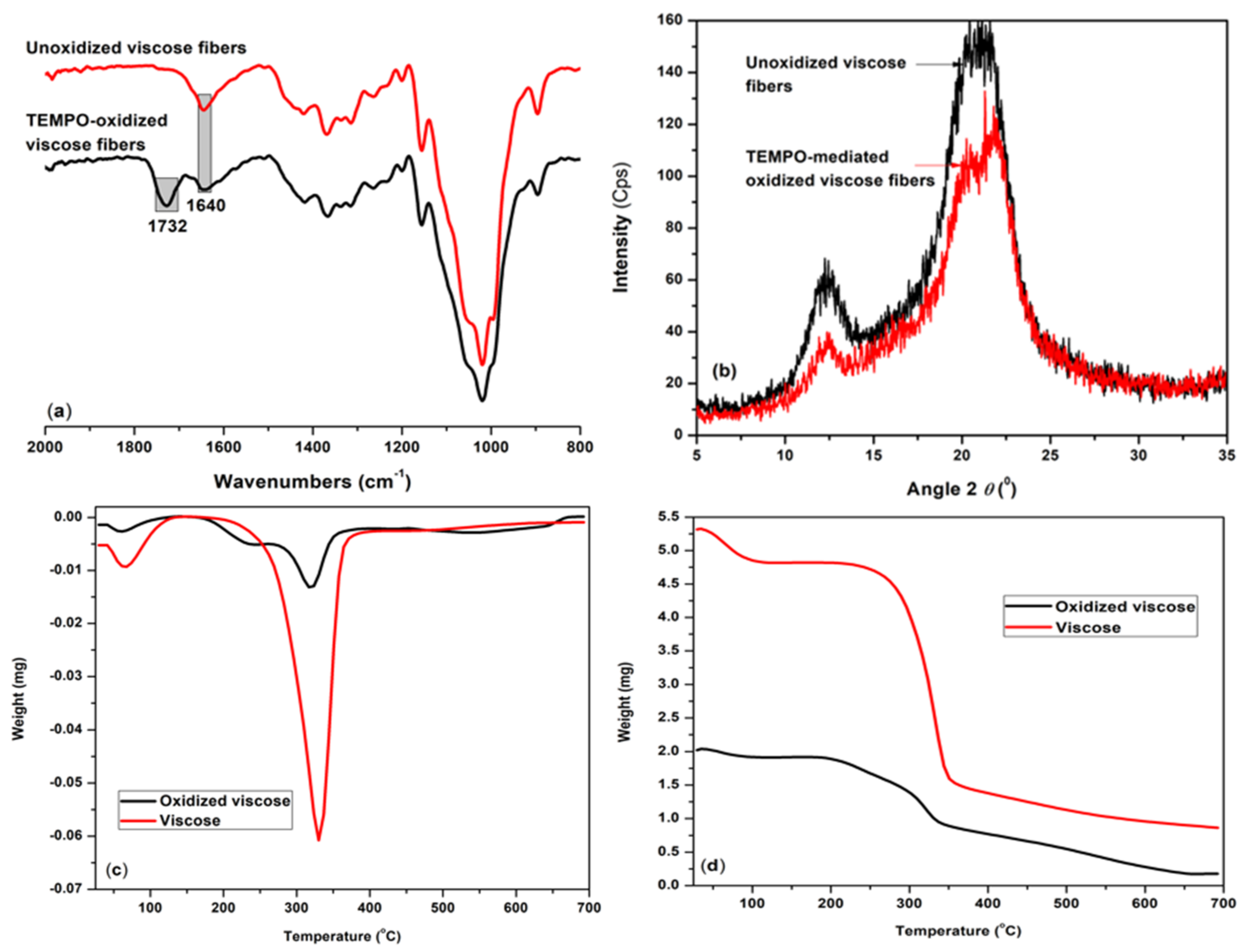

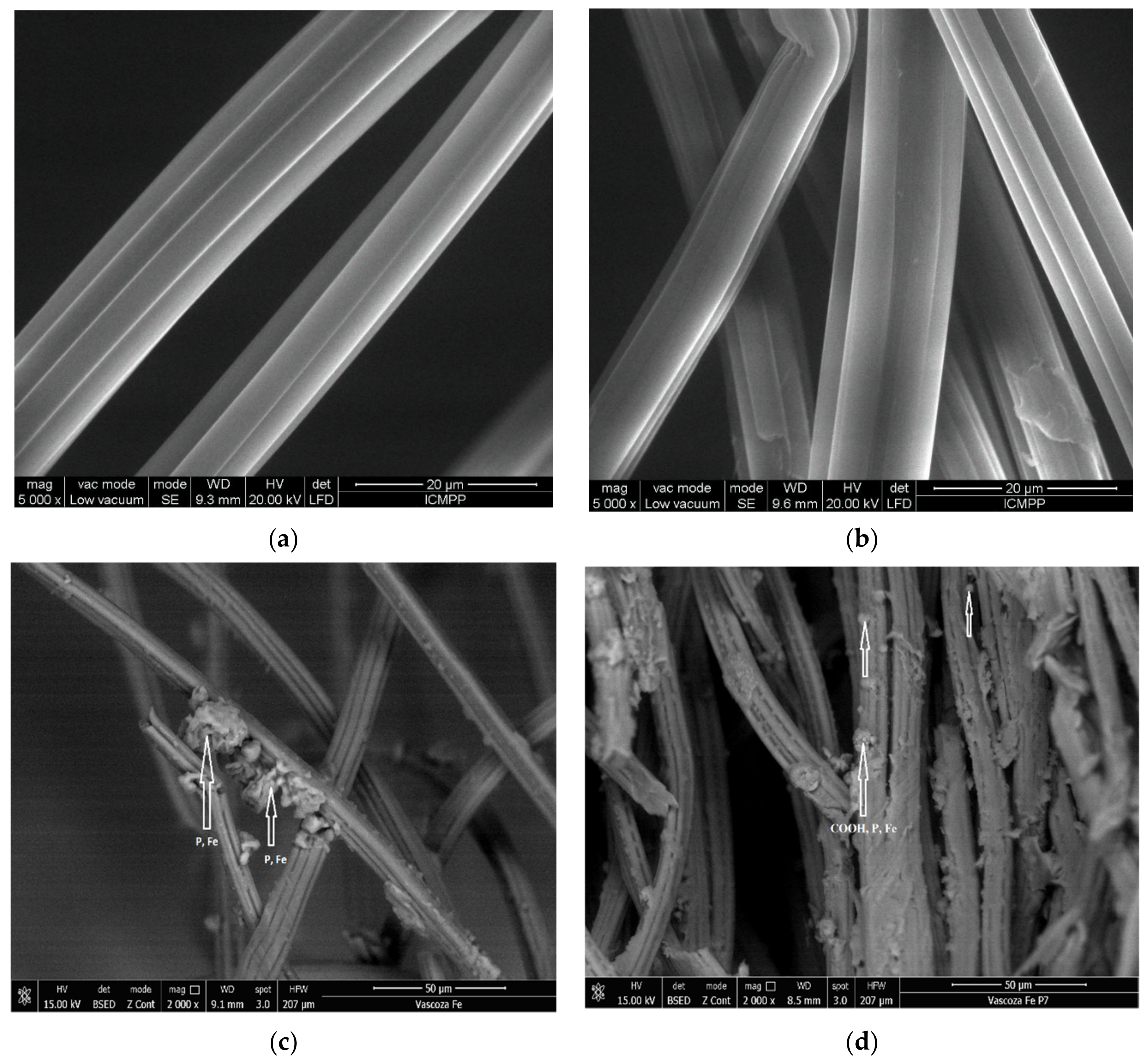
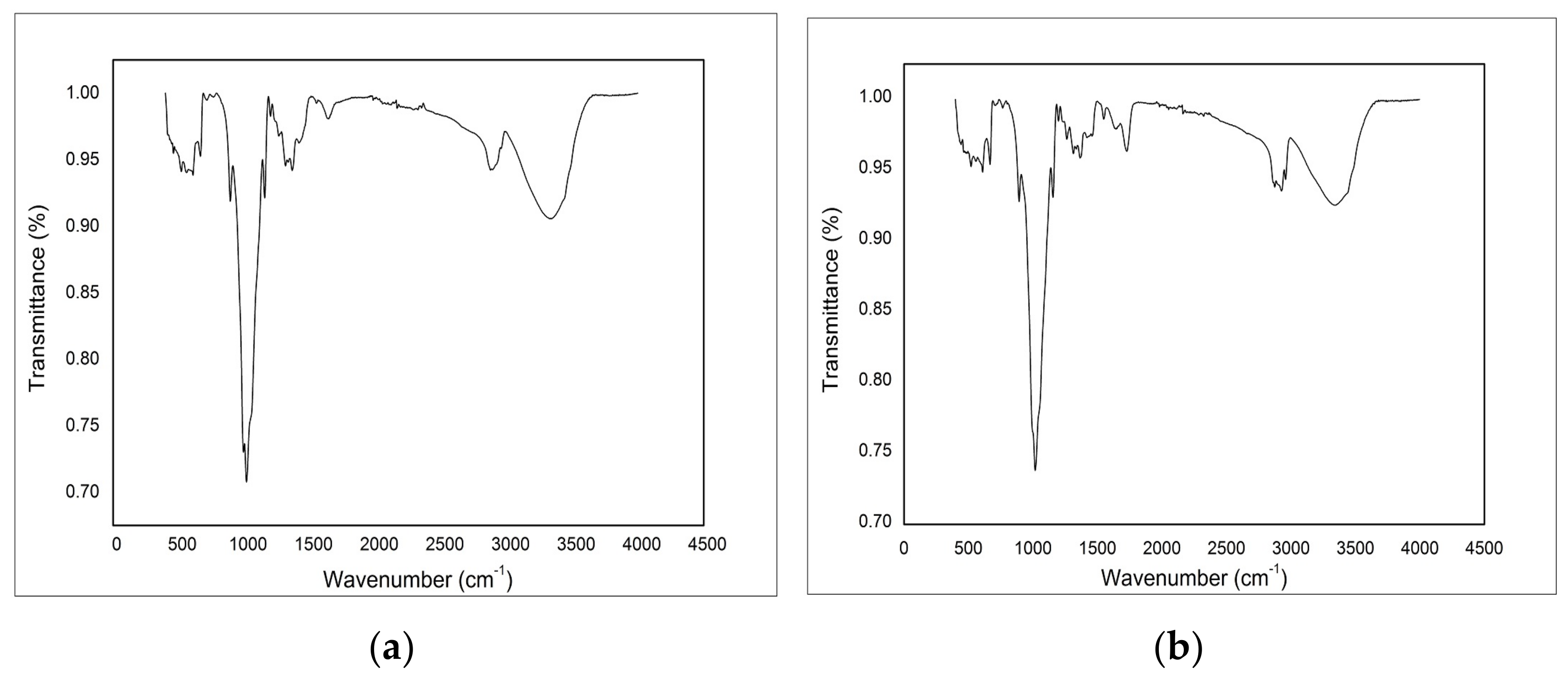
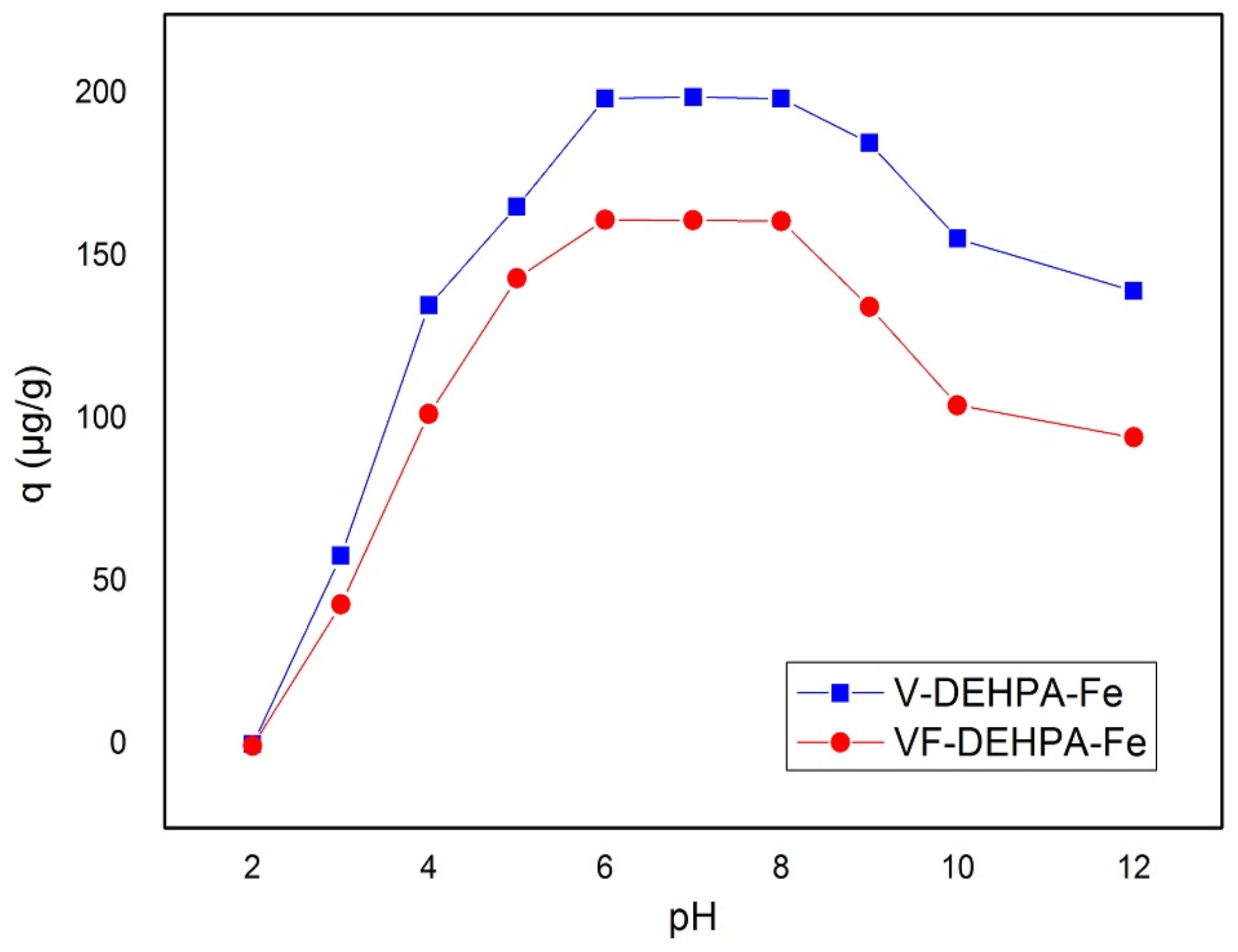
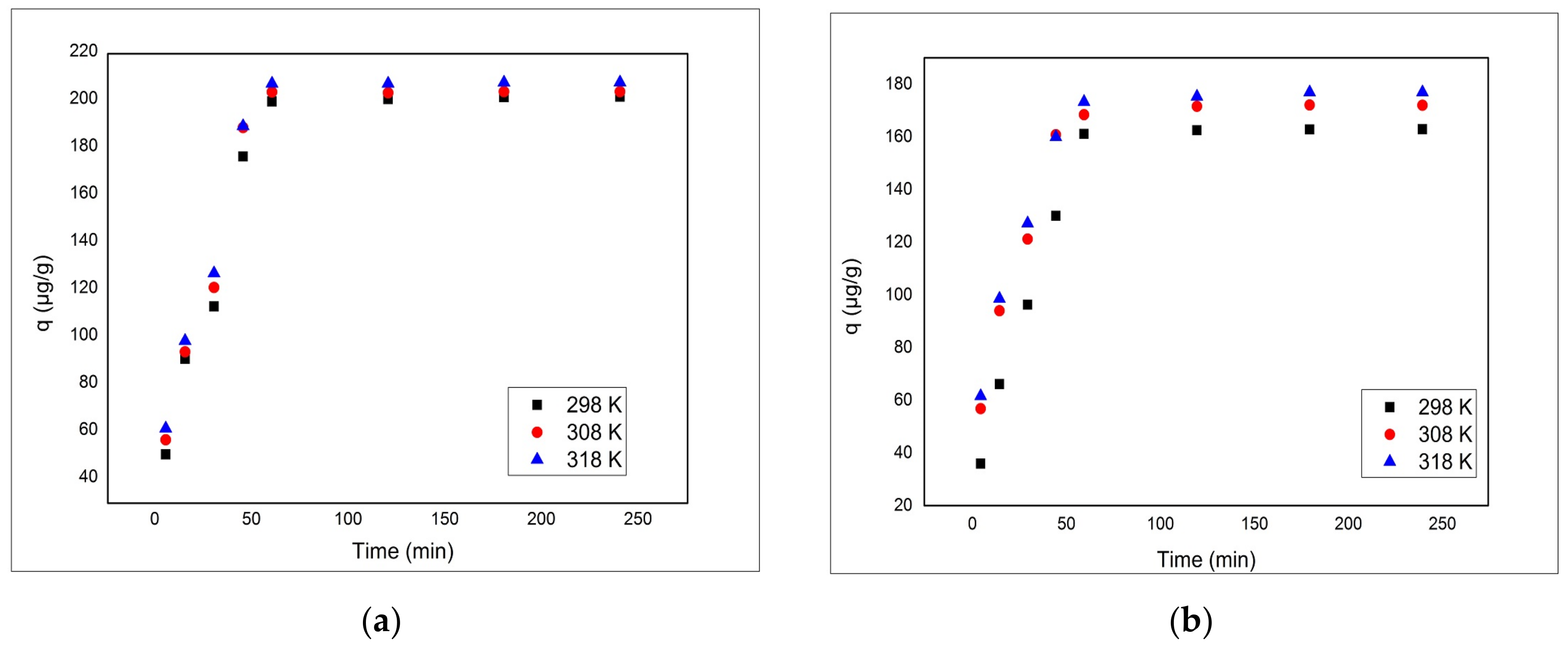
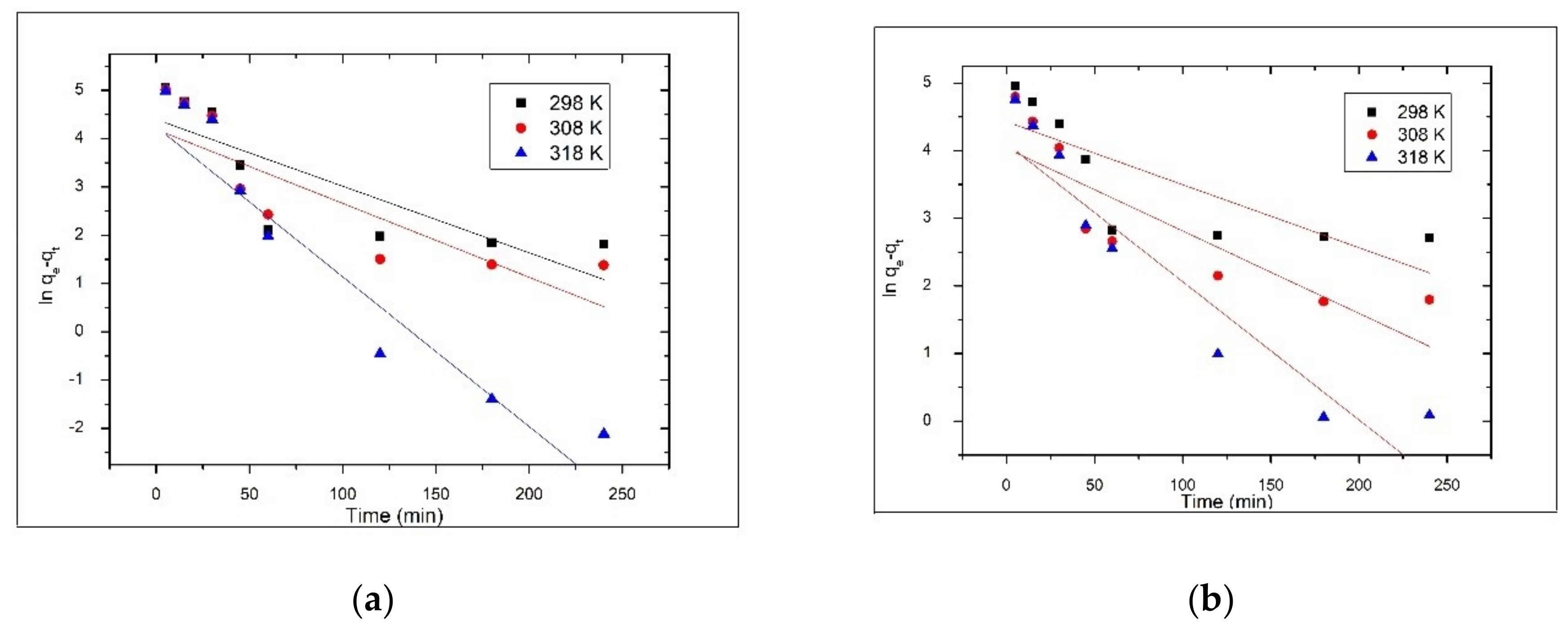
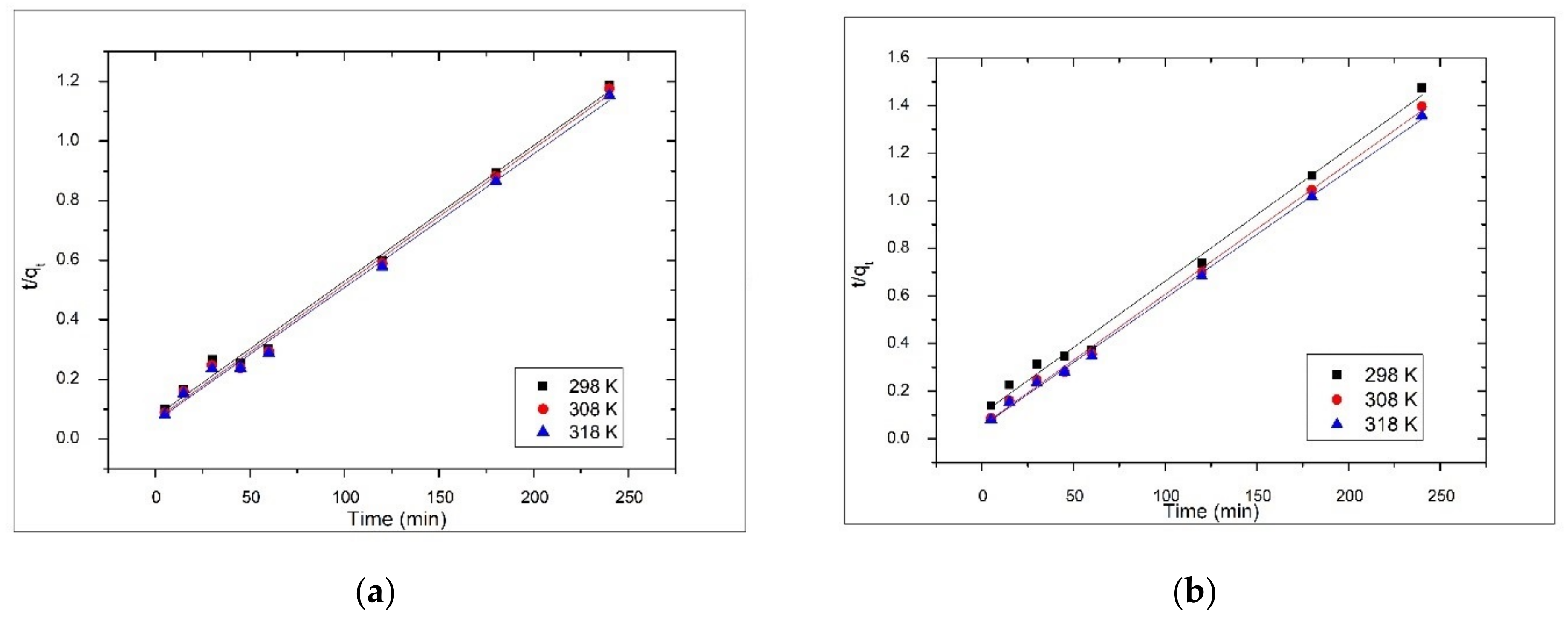
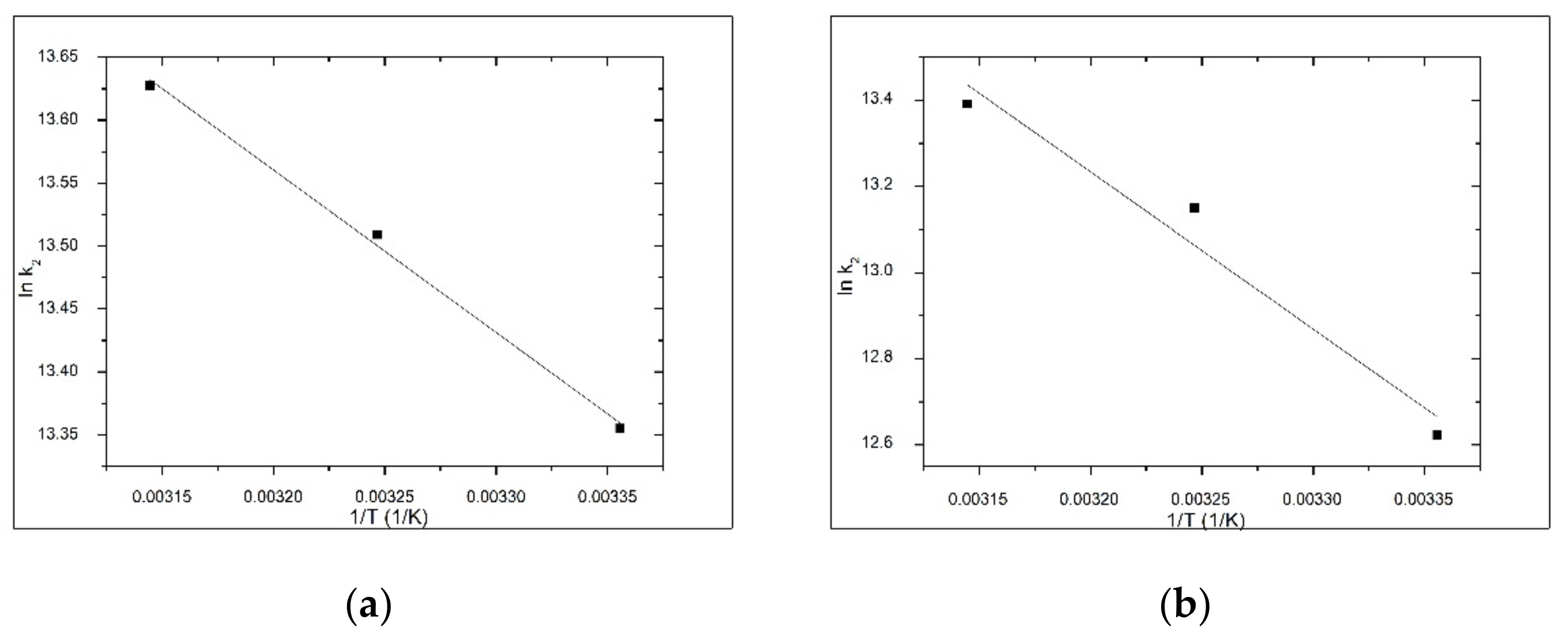


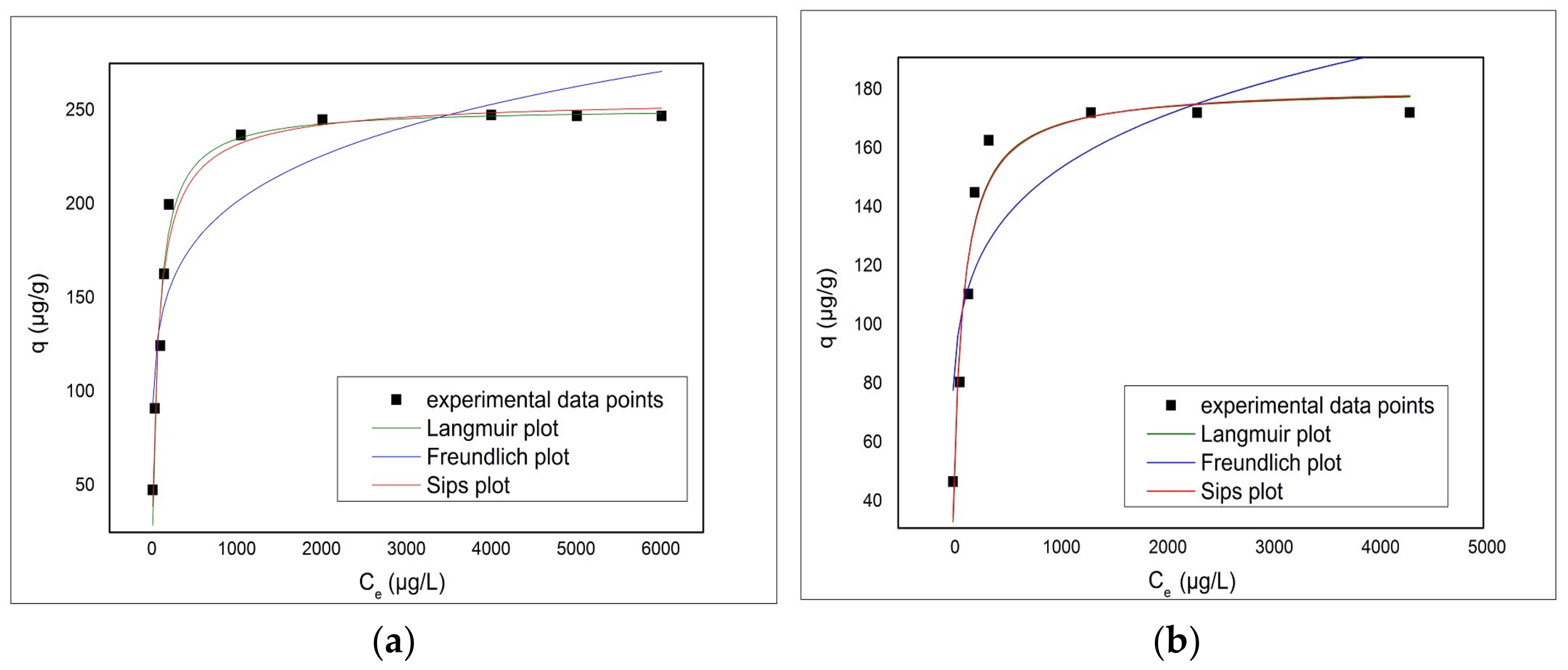
| Temp, (K) | qe,exp, µg g−1 | Pseudo-First Order Kinetic Model | Pseudo-Second Order Kinetic Model | ||||||
|---|---|---|---|---|---|---|---|---|---|
| qe,calc, µg g−1 | ks1, min−1 | R2 | χ2 | qe,calc, µg g−1 | ks2, min−1 (µg/g)−1 | R2 | χ2 | ||
| 298 | 199.8 | 80.88 | 0.0138 | 0.6252 | 0.46 | 217.4 | 63.1·104 | 0.9920 | 1.5·10−4 |
| 308 | 203.8 | 65.89 | 0.0153 | 0.5624 | 0.57 | 217.4 | 73.6·104 | 0.9928 | 1.4·10−4 |
| 318 | 207.4 | 69.48 | 0.0310 | 0.7424 | 0.79 | 222.2 | 82.8·104 | 0.9941 | 1.3·10−4 |
| Temp, (K) | qe,exp, µ/g−1 | Pseudo-First Order Kinetic Model | Pseudo-Second Order Kinetic Model | ||||||
|---|---|---|---|---|---|---|---|---|---|
| qe,calc, µg g−1 | ks1, min−1 | R2 | χ2 | qe,calc, µg g−1 | ks2, min−1 (µg/g)−1 | R2 | χ2 | ||
| 298 | 161.1 | 83.82 | 0.0093 | 0.6015 | 0.32 | 178.6 | 30.3·104 | 0.9927 | 1.7·10−4 |
| 308 | 168.4 | 56.49 | 0.0122 | 0.6206 | 0.41 | 181.8 | 60.3·104 | 0.9975 | 1.0·10−4 |
| 318 | 173.3 | 60.77 | 0.0204 | 0.8041 | 0.44 | 185.2 | 65.4·104 | 0.9982 | 8.5·10−5 |
| Temperature, K | V-DEHPA-Fe | V-DEHPA-Fe | ||||||
|---|---|---|---|---|---|---|---|---|
| Kd, L g−1 | ΔG0, kJ mol−1 | ΔH0, kJ mol−1 | ΔS0, kJ (mol K)−1 | Kd, L g−1 | ΔG0, kJ mol−1 | ΔH0, kJ mol−1 | ΔS0, kJ (mol K)−1 | |
| 298 | 1.06 | −0.18 | 7.57 | 26.01 | 1.16 | −0.38 | 7.28 | 25.74 |
| 308 | 1.21 | −0.44 | 1.29 | −0.64 | ||||
| 318 | 1.29 | −0.71 | 1.39 | −0.90 | ||||
| Adsorption Isotherms | Parameters | V-DEHPA-Fe | VF-DEHPA-Fe |
|---|---|---|---|
| Experimental Values | |||
| qm,exp (µg g−1) | 247.5 | 171.2 | |
| Isotherm Models Values | |||
| Langmuir | qL (µg g−1) | 251.3 | 179.7 |
| KL (L mg−1) | 0.014 | 0.013 | |
| R2 | 0.9728 | 0.9398 | |
| Freundlich | KF (L mg−1) | 64.13 | 48.23 |
| 1/nF | 0.165 | 0.165 | |
| R2 | 0.8317 | 0.7229 | |
| Sips | qS (µg/g) | 257.3 | 180.4 |
| KS | 0.028 | 0.015 | |
| 1/nS | 0.164 | 0.029 | |
| R2 | 0.9747 | 0.9280 | |
| Material | Adsorption Capacity q (μg/g) | Reference |
|---|---|---|
| Fe-XAD7-DEHPA | 15.7 | [101] |
| XAD8-DEHPA-Fe | 13 | [91] |
| IR-120 (Na)-DEHPA-Fe | 21.8 | [101] |
| XAD-7-DEHPA-TOPO-Fe | 35.5 | [102] |
| XAD-7-DEHPA-TPPO-Fe | 29.8 | [102] |
| Dibenzo-18-crown-6-Fe | 30 | [83] |
| SiO2 | 21.5 | [103] |
| MgSiO3 | 2.75 | [103] |
| V-DEHPA-Fe | 247.5 | Present paper |
| VF-DEHPA-Fe | 171.2 | Present paper |
Publisher’s Note: MDPI stays neutral with regard to jurisdictional claims in published maps and institutional affiliations. |
© 2021 by the authors. Licensee MDPI, Basel, Switzerland. This article is an open access article distributed under the terms and conditions of the Creative Commons Attribution (CC BY) license (https://creativecommons.org/licenses/by/4.0/).
Share and Cite
Ciopec, M.; Biliuta, G.; Negrea, A.; Duțeanu, N.; Coseri, S.; Negrea, P.; Ghangrekar, M. Testing of Chemically Activated Cellulose Fibers as Adsorbents for Treatment of Arsenic Contaminated Water. Materials 2021, 14, 3731. https://doi.org/10.3390/ma14133731
Ciopec M, Biliuta G, Negrea A, Duțeanu N, Coseri S, Negrea P, Ghangrekar M. Testing of Chemically Activated Cellulose Fibers as Adsorbents for Treatment of Arsenic Contaminated Water. Materials. 2021; 14(13):3731. https://doi.org/10.3390/ma14133731
Chicago/Turabian StyleCiopec, Mihaela, Gabriela Biliuta, Adina Negrea, Narcis Duțeanu, Sergiu Coseri, Petru Negrea, and Makarand Ghangrekar. 2021. "Testing of Chemically Activated Cellulose Fibers as Adsorbents for Treatment of Arsenic Contaminated Water" Materials 14, no. 13: 3731. https://doi.org/10.3390/ma14133731
APA StyleCiopec, M., Biliuta, G., Negrea, A., Duțeanu, N., Coseri, S., Negrea, P., & Ghangrekar, M. (2021). Testing of Chemically Activated Cellulose Fibers as Adsorbents for Treatment of Arsenic Contaminated Water. Materials, 14(13), 3731. https://doi.org/10.3390/ma14133731









